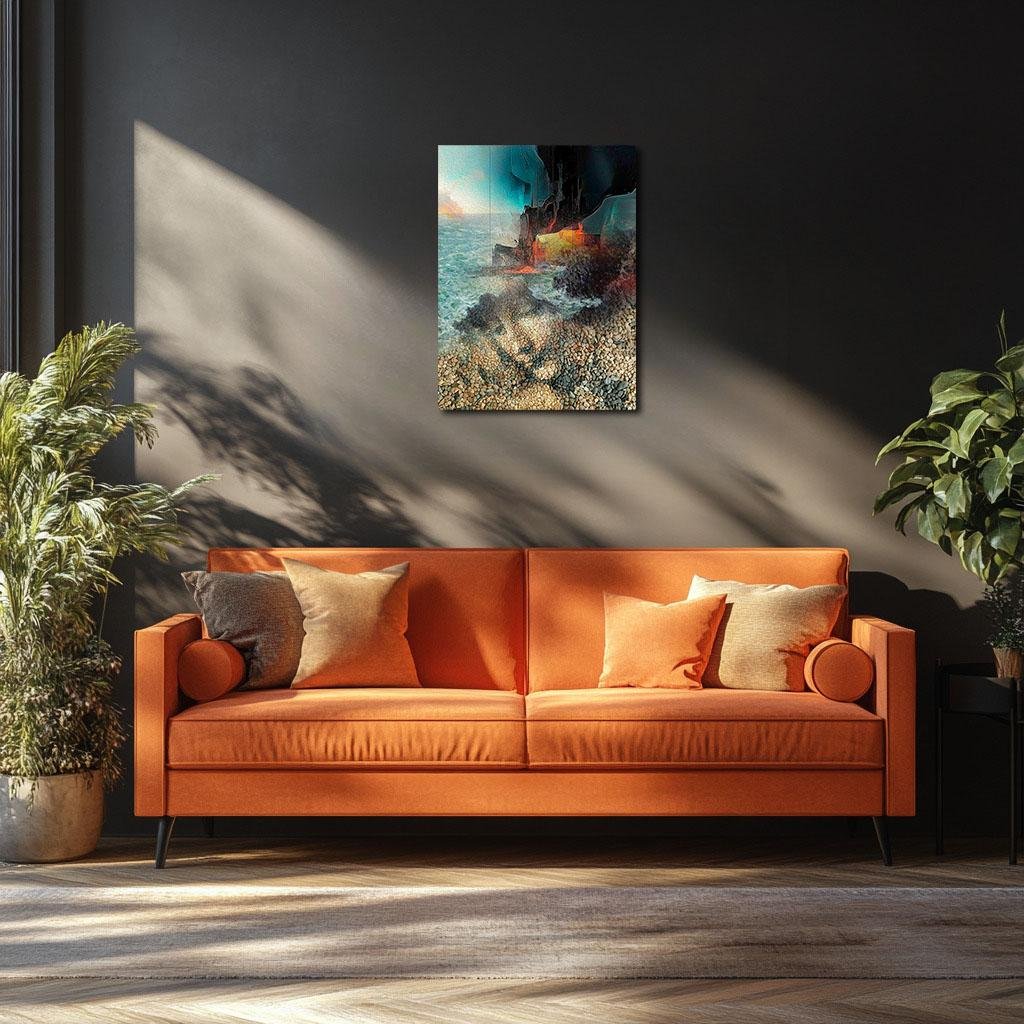Whispers of the Shore: Perception and Permanence
This conceptual, surreal reinterpretation of Monet’s The Côte Sauvage, the Cliffs of Belle-Île (1886) contrasts dramatic cliffs painted with bold colors against a gentle human face formed from delicate pebbles. The composition symbolizes humanity’s transient existence within the powerful permanence of nature. Abstracted, flowing brushstrokes evoke the shifting nature of perception, illustrating how reality, emotion, and memory intertwine. Through visual and emotional contrasts, this artwork explores themes of permanence, fragility, and the profound, eternal connection between humans and their environment.
Please see Below for Details…
Hotline Order:
Mon - Fri: 07AM - 06PM
404-872-4663
Claude Monet’s The Côte Sauvage, the Cliffs of Belle-Île (1886) transcends the conventional representation of coastal cliffs—it captures the profound tension between permanence and transience, solidity and fluidity. Monet, deeply captivated by the fierce beauty of the Belle-Île coast, visited repeatedly, studying the rugged cliffs, violent waves, and the ever-changing interplay of light, air, and water. Each brushstroke was an exploration, a quest to understand not just the visual appearance but the emotional resonance inherent in nature’s most intense and dramatic expressions.
This conceptual reinterpretation expands Monet’s original vision, merging it with layers of surreal abstraction, creating a symbolic narrative of memory, impermanence, and the perpetual search for meaning within chaos. Here, the cliffs are more than rock formations—they become metaphors, physical manifestations of the complex emotions humanity feels when confronted by the magnitude and timelessness of nature. The scene depicted is both a recognizable place and a mysterious emotional landscape, inviting the viewer deeper into contemplation and reflection.
Central to the artwork is a striking juxtaposition between sharp, dramatic cliffs and the soft, nuanced textures of small, rounded pebbles forming an ethereal human face. The cliffs themselves rise sharply from the sea, rendered in powerful hues of deep turquoise and rich, dark blues, interspersed with radiant touches of gold, ochre, and fiery orange. The bold, aggressive brushwork captures the inherent violence and dynamism of nature's elements at Belle-Île—the relentless crashing waves, the raw edges of rock formations, and the ever-changing coastal light that fascinated Monet. Here, the cliffs are symbols of permanence and endurance, guardians of land facing the timeless battle with the ocean.
Yet, emerging subtly from the lower half of the composition is a ghostly visage carefully constructed from innumerable small stones and pebbles. This human face, gentle and reflective, represents humanity's delicate and transient presence within this overwhelming natural environment. Each pebble symbolizes a memory, a moment, a fragment of experience, gradually accumulated into a coherent yet fragile portrait. Its delicate presence contrasts dramatically with the monumental strength and apparent permanence of the cliffs. Through this contrast, the artwork poignantly reminds us of the human condition—our constant endeavor to leave a mark, build lasting memories, and find permanence in an inherently impermanent world.
Above the pebble face, the cliffs melt into abstraction—colors merging and flowing, edges dissolving into ethereal forms, as if reality itself is being reimagined through the lens of memory and imagination. The abstraction introduces a dreamlike quality, highlighting how human perception continuously reshapes and alters our understanding of nature. It speaks of Monet’s lifelong fascination with perception—how reality shifts depending on the observer’s state of mind, emotional depth, and personal experiences. Thus, the cliffs depicted are no longer purely geological but psychological, reshaped by human consciousness and emotion.
In the background, Monet’s beloved sea spreads infinitely, colored in nuanced, layered blues, greens, and misty grays. Its textured waves ripple gently yet powerfully, the ocean simultaneously calming and menacing. It becomes a metaphor for the fluidity of human emotions—ever-shifting, at times peaceful, at others turbulent and unpredictable. This interplay symbolizes Monet’s own artistic journey and his exploration of how the environment around us mirrors our inner emotional worlds. It suggests the interconnectedness between human consciousness and the natural world—one reflecting and influencing the other in an endless dance.
The choice of palette is deliberately harmonious yet emotionally evocative. The stark contrasts between soft earth tones, the vibrant blues of the ocean, and the fiery oranges illuminating the cliffs create visual and emotional depth. This chromatic tension emphasizes the underlying conceptual themes of contrast—permanence versus impermanence, solidity versus fluidity, and nature’s power versus human fragility.
My goal with this reinterpretation was to offer an artistic meditation on human existence and our enduring yet fragile relationship with nature. Monet originally painted the cliffs at Belle-Île to capture nature’s raw intensity, yet here, that intensity has been extended into a reflection on the human psyche—its complexities, vulnerabilities, and enduring resilience in the face of forces beyond its control. The pebbles assembling into a human face subtly remind us that even our strongest memories, emotions, and identities are formed of transient fragments that can be washed away as easily as stones on a shore.
Through this artwork, I aimed to create a space for contemplation about the permanence of nature contrasted with the ephemeral nature of human life and perception. It invites viewers to reflect on their own experiences, memories, and feelings when confronted with nature’s grandeur. In merging Monet’s artistic vision with conceptual abstraction, I sought to show that true understanding arises not simply from observing but from feeling deeply, from recognizing our own humanity in the raw power and beauty of the natural world around us.
Add your review
Your email address will not be published. Required fields are marked *
Please login to write review!
Looks like there are no reviews yet.








